Fresh basil at your fingertips?
Mint growing just a few steps from your kitchen?
Growing fresh herbs at home is an excellent way to add tremendous flavor to your meals, boost your nutrients and save some money in the process!
In many parts of the country, this is a perfect time to get started!
Some of our favorite farmers and gardeners always tell us to wait until at least Mother’s Day to plant your fresh herbs. Don’t be intimidated — growing fresh herbs is super easy — if we can do it, anyone can! And it’s absolutely priceless to have fresh herbs at your fingertips ready to use in the kitchen to help make incredibly delicious meals!
Home-grown herbs provide a nutritional boost.
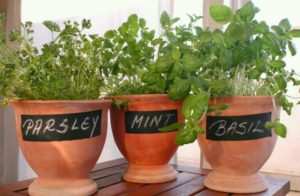 Believe it or not, a lot of nutritional value is lost shortly after herbs are picked. By growing your own, you can maximize the nutritional value by harvesting right when you need them! Think about it — if you recently purchased herbs at the store, when were they picked? By the time they are harvested, transported to the store, purchased and finally used in your meals, their nutritional value is dramatically diminished. But to be able to step outside your door and throw them straight into your meal — now that is fresh!
Believe it or not, a lot of nutritional value is lost shortly after herbs are picked. By growing your own, you can maximize the nutritional value by harvesting right when you need them! Think about it — if you recently purchased herbs at the store, when were they picked? By the time they are harvested, transported to the store, purchased and finally used in your meals, their nutritional value is dramatically diminished. But to be able to step outside your door and throw them straight into your meal — now that is fresh!
Which herbs to choose?
If you do a lot of cooking (and we hope you do!), it would be best to choose herbs that you most commonly cook with (or would like to cook with). This might include basil, oregano, parsley, dill, mint, rosemary, chives, sage or thyme. If you are still not sure, use aroma as your guide…choose the ones that are most appealing and, remember, aroma can be a good indicator of quality!
How do you plant herbs?
- Most herbs should be grown in 12-14 inch pots or containers with potting soil. Smaller herbs can be grown in 10 inch pots. A good rule of thumb is, if you are not sure, GO BIGGER!
- The type of container you use is personal preference. Terra-cotta clay pots are very popular, but they can break if dropped and they tend to dry out quickly. Wooden and ceramic containers are available in a variety of styles, but can be heavy and difficult to move. Plastic containers can be affordable, durable, lightweight, and come in a variety of colors and style choices.
- No matter which pots you choose, make sure there is proper drainage! If your pot has drain holes in the bottom, set it up off the ground with rocks or bricks so it can drain well. Or, if not off the ground, you can add a couple of drain holes on the sides, about one inch from the bottom of the pot.
- For the dirt, a good topsoil or potting mix is a great option, especially one that is organic or formulated for vegetables. Mixing in compost is even better. Herbs don’t need a lot of fertilizer with the right soil.
- For location, most herbs like full sun, or at least 6 hours, and (with the exception of cilantro) even do well in hot summer temperatures, as long as you keep the soil moist.
A word of advice with mint — it will typically grow back every year and we highly recommend putting mint in its own pot — it takes off fast and can overtake a large area, so a dedicated container will help keep it confined!
Pinching is the key to success!
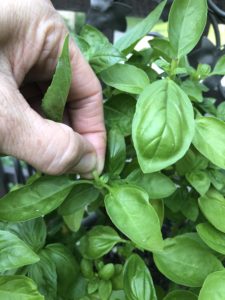 One of the best tips we have ever learned about herbs is pinching! Pinching is what you do to herbs to harvest or pick them — and pinching promotes growth!
One of the best tips we have ever learned about herbs is pinching! Pinching is what you do to herbs to harvest or pick them — and pinching promotes growth!
If you are growing herbs for the beautiful flowers they produce, then let them be and enjoy! But, if you are growing your herbs to use in the kitchen, it’s important to pinch them and keep them from flowering. Once an herb begins to produce flower blooms, the leaves can lose their flavor and become bitter.
- The goal is to harvest your herbs from the stem, not just pick off individual leaves. For example, you want to pinch once your herb has a few pairs of leaves on a stem.
- Herbs grow buds at the base of each leaf, just above where the leaf connects to the stem. To stimulate these to grow new stems, remove the growth just above the buds (but don’t damage the buds!). Just use your fingernail — you don’t need special tools!
- You also want to harvest from the top of the plant. Leave the most mature leaves at the base of your plant to serve as the powerhouse for producing more growth. Don’t cut thyme or oregano by more than half their total height, and rosemary and sage shouldn’t be cut back by more than one third of their height.
Once your herbs are growing, now what?
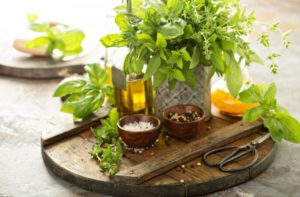 After picking your herbs, wash and cut and add them to your culinary creations. Keep in mind, it’s best to add fresh herbs at the end of the cooking process. (If you are using dried herbs, they can be added earlier in the cooking process.)
After picking your herbs, wash and cut and add them to your culinary creations. Keep in mind, it’s best to add fresh herbs at the end of the cooking process. (If you are using dried herbs, they can be added earlier in the cooking process.)
In salads, you want to add fresh herbs a little while before serving, if possible, because this will give the herbs time to release their flavors. Fresh herbs are great to use instead of dried herbs, but you should double or triple the amount of fresh herbs because the flavors aren’t as concentrated.
How to store fresh herbs?
You can store fresh herbs loosely wrapped in damp paper towels and in a plastic bag in the refrigerator for about one week. You can also freeze fresh herbs to preserve them and enjoy year round! There are two types — soft herbs and hard herbs — and they should be preserved differently.
Soft herbs: like basil, parsley, oregano and mint. To freeze soft herbs: wash, chop and place in an ice cube tray. Cover with a little water (don’t let it overflow) and freeze for 24 hours. Remove the herb ice cubes and store in a sealed plastic bag in the freezer until ready to use. Now they can be easily added to soups, stews or other recipes.
Hard herbs: such as rosemary, thyme, and sage. To freeze hard herbs: wash the herbs and place in a sealed plastic bag and place in the freezer. When you are ready to use, the frozen leaves should easily fall off the stem and they can be chopped and added to your recipe. For more tips and ideas on not only preserving fresh herbs, but fruits and vegetables too, see our coaching tip Preserving Summertime Flavors.
Here’s the fun part…enjoying fresh herbs in your meals!
With all these fresh herbs available to use for various foods and recipes, here are just a few ideas:
Pesto Magic! Fresh herbs, such as basil, can make an amazing, mouthwatering pesto you can use to turn meals into masterpieces. Pesto can magically transform plain pasta into one delicious meal! See how easy it is to make your own pesto in our coaching tip Abracadabra Pesto!
Basil – probably the lowest maintenance herb to grow and we have a TON of recipes! Try these delicious ideas:
Cherry Tomato Margherita Pizza
Mushroom Tomato Basil Bruschetta
Summer Basil & Peach Grilled Chicken
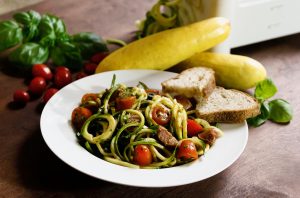
Linguine with Basil Tomato Sauce
Pesto Fish Packet with Tomatoes & Green Onions
Blueberry Apricot Spinach Salad
Sun Dried Tomato Caprese Grilled Cheese
Parsley – grows a little slower than others, but is very easy to grow. We think you will love these:
Grilled Chimichurri Chicken & Veggie Skewers
Roasted Veggie Salad with Chimichurri
Green Beans & Zucchini with Sauce Verte
Lamb Crostini with Asparagus Gremolata
Cauliflower & Kale Detox Salad
Mint – grows fast and likes to have space! Enjoy in a variety of ways:
Strawberry Salad with Strawberry Mint Vinaigrette
Asparagus & Radishes with Mint
Sweet Orange Roasted Fennel & Radish Salad
Minted Orzo and Zucchini Salad
Minty Cucumber Cantaloupe Salad
Rosemary – loves full sun and frequent watering. You can’t go wrong using fresh rosemary in these ideas:
Pear & Blue Cheese Pizza with Rosemary
Watermelon with Yogurt & Toasted Rosemary
Honey Dijon Roasted Potatoes with Rosemary
Garlic Parmesan Rosemary Popcorn
Beer Marinated Rosemary Potatoes
Garlic, Lemon & Rosemary Lamb Chops
Dill – likes full sun, needs water about once a week and can grow tall so it may need a stake support. Try dill in these great-tasting recipes:
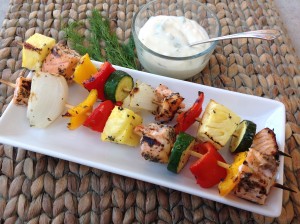 Salmon Kabobs with Creamy Dill Sauce
Salmon Kabobs with Creamy Dill Sauce
Radishes with Sugar Snap Peas & Dill
Zucchini Sticks with Yogurt Dill Sauce
Roasted Green Beans with Dill Sauce
Creamy Cucumber & Fennel Salad
Sage – slightly more high maintenance — likes sun, good soil and needs water every other day. Check out these ideas:
Sausage, Apple & Onion Chicken Skillet
Cranberry Apple Sausage Dressing
Thyme – easy to grow and use in cooking, the leaves are so small they usually don’t require chopping. Thyme is an excellent addition to omelets or frittatas, and adds a ton of flavor to most soups. See what we mean with the Mini Frittatas or Tuscan Bean Soup! Plus, check out the Farmers’ Market Fish Packet and the Citrus Oven Roasted Chicken!
Go ahead and get started to see how easy it is to grow your own herbs!
Please share YOUR favorites and any other helpful tips!
 LEARN MORE ABOUT THE NAPKIN!
LEARN MORE ABOUT THE NAPKIN!



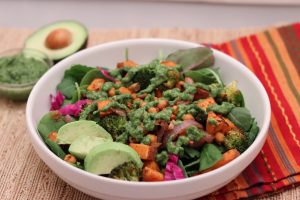

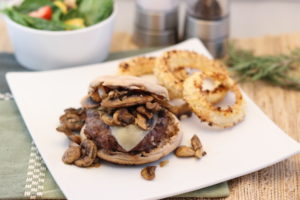
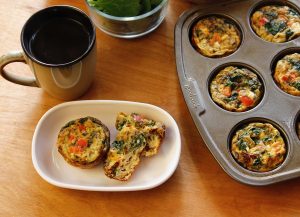

Thanks for the Herb lesson and ways to use them AND care for them!! It was just awesome to find this on your web site.
Thanks for all you do!
Of course, thank you! We are grateful for the feedback and are so glad this helped!